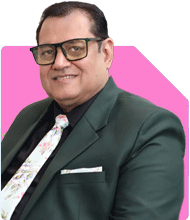My 12-Year-Old Son Has High SGPT Levels: What Should I Do?
Dr Deepa Suvarna |171 Answers |Ask -Follow
Paediatrician - Answered on Apr 20, 2024

Hi My son from few days has abdomen pain and vomiting tendency. He don't eat due to the above problem due to which he has become very lean and thin. He has lost considerable amount of weight. We have consulted a physician and he has asked us to carry out SGPT test. The outcome of which is high and so we are very concerned about his health.His age is only 12 years. What should we do in this case?
You may like to see similar questions and answers below
Dr Ashish Sehgal | Answer |Ask -Follow
Relationships Expert, Mind Coach - Answered on Mar 01, 2023
Dr Deepa Suvarna |171 Answers |Ask -Follow
Paediatrician - Answered on Aug 08, 2023
Dr Deepa Suvarna |171 Answers |Ask -Follow
Paediatrician - Answered on Sep 04, 2023
Dr Deepa Suvarna |171 Answers |Ask -Follow
Paediatrician - Answered on May 27, 2024
Dr Deepa Suvarna |171 Answers |Ask -Follow
Paediatrician - Answered on Jul 10, 2025
Ramalingam Kalirajan |10906 Answers |Ask -Follow
Mutual Funds, Financial Planning Expert - Answered on Dec 19, 2025
Nayagam P P |10859 Answers |Ask -Follow
Career Counsellor - Answered on Dec 19, 2025
Ramalingam Kalirajan |10906 Answers |Ask -Follow
Mutual Funds, Financial Planning Expert - Answered on Dec 19, 2025
Ramalingam Kalirajan |10906 Answers |Ask -Follow
Mutual Funds, Financial Planning Expert - Answered on Dec 19, 2025
Ramalingam Kalirajan |10906 Answers |Ask -Follow
Mutual Funds, Financial Planning Expert - Answered on Dec 19, 2025
Radheshyam Zanwar |6751 Answers |Ask -Follow
MHT-CET, IIT-JEE, NEET-UG Expert - Answered on Dec 19, 2025
Radheshyam Zanwar |6751 Answers |Ask -Follow
MHT-CET, IIT-JEE, NEET-UG Expert - Answered on Dec 19, 2025
Samraat Jadhav |2514 Answers |Ask -Follow
Stock Market Expert - Answered on Dec 18, 2025
Reetika Sharma |432 Answers |Ask -Follow
Financial Planner, MF and Insurance Expert - Answered on Dec 18, 2025
Reetika Sharma |432 Answers |Ask -Follow
Financial Planner, MF and Insurance Expert - Answered on Dec 18, 2025


























